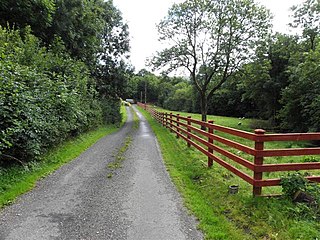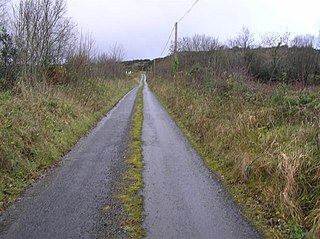Related Research Articles

Drumcask is a townland in the civil parish of Kinawley, barony of Tullyhaw, County Cavan, Ireland. It is close to the site of a medieval church in Killaghaduff townland, which might explain the meaning of the name.

Derryrealt is a townland in the civil parish of Kinawley, barony of Tullyhaw, County Cavan, Ireland.

Cornalon is a townland in the civil parish of Kinawley, barony of Tullyhaw, County Cavan, Ireland.

Borim is a townland in the civil parish of Kinawley, barony of Tullyhaw, County Cavan, Ireland. A sub-division is called The Knocken. The 1938 Dúchas collection states- it is a field in the farm of Mr Patrick McGovern. It is a high bank over a river with a lone bush growing in it.

Dunglave is a townland in the civil parish of Kinawley, barony of Tullyhaw, County Cavan, Ireland.
Drumcanon is a townland in the civil parish of Kinawley, barony of Tullyhaw, County Cavan, Ireland.

Drumcar is a townland in the civil parish of Kinawley, barony of Tullyhaw, County Cavan, Ireland.
Drumcullion is a townland in the civil parish of Kinawley, barony of Tullyhaw, County Cavan, Ireland.

Drumboory is a townland in the civil parish of Kinawley, barony of Tullyhaw, County Cavan, Ireland.

Aghakinnigh is a townland in the civil parish of Kinawley, barony of Tullyhaw, County Cavan, Ireland. A sub-division is called Mullach Bán. The 1938 Dúchas folklore collection states- Mullac ban- A name given to a hill in Aughakinnagh, Swanlinbar. It is locally supposed there is a white sand stone quarry under it.
Drumersee is a townland in the civil parish of Kinawley, barony of Tullyhaw, County Cavan, Ireland.
Drumbar is a townland in the civil parish of Kinawley, barony of Tullyhaw, County Cavan, Ireland.

Drumbrughas is a townland in the civil parish of Kinawley, barony of Tullyhaw, County Cavan, Ireland.
Gortnaderrylea is a townland in the civil parish of Kinawley, barony of Tullyhaw, County Cavan, Ireland.

Uragh is a townland in the civil parish of Kinawley, barony of Tullyhaw, County Cavan, Ireland.

Gortacashel is a townland in the civil parish of Kinawley, barony of Tullyhaw, County Cavan, Ireland.
Drumconra is a townland in the civil parish of Kinawley, barony of Tullyhaw, County Cavan, Ireland. The townland is also called Lowforge, meaning 'The Lower Forge' belonging to the 18th century Swanlinbar Iron Works. A sub-division is called The Coal Yard. The 1938 Dúchas collection states- The Coal Yard - a field belonging to Mr. Patrick McGoldrick, Drumcondra, Swanlinbar Co Cavan. Long ago iron was smelted there and there are traces of this under each sod that is dug up. Another sub-division is called The Fairy Field. The Dúchas collection states- This is owned by Mr Barney Kellaher, Drumcondra, Swanlinbar. There is a peculiar shaped stone in it which is never touched. It is said locally that one time a person who tried to remove it was found dead next morning and since then no one would touch it.

Cornagran is a townland in the civil parish of Kinawley, barony of Tullyhaw, County Cavan, Ireland.

Cloghoge is a townland in the civil parish of Kinawley, barony of Tullyhaw, County Cavan, Ireland.

Killaghaduff is a townland in the civil parish of Kinawley, barony of Tullyhaw, County Cavan, Ireland.
References
- ↑ "Placenames Database of Ireland" . Retrieved 29 February 2012.
- ↑ "IreAtlas" . Retrieved 29 February 2012.
- ↑ The National Archives (30 September 2009). "Map of Tullyhaw, County Cavan (MPF 1/58)" (PDF). National Archives Dublin. Retrieved 6 July 2019.
- ↑ "Down Survey Maps | The Down Survey Project". downsurvey.tcd.ie.
- ↑ "The Carvaghs: A List Of The Several Baronies And Parishes in the County Of Cavan" (PDF). 7 October 2011. Archived from the original (PDF) on 10 March 2022. Retrieved 6 July 2019.
- ↑ "007246490_00341" (PDF). 11 December 2013. Retrieved 6 July 2019.
- ↑ "004625688/004625688_00050.pdf" (PDF). 4 July 2012. Retrieved 6 July 2019.
- ↑ "Valuation Office Books". census.nationalarchives.ie.
- ↑ "Griffith's Valuation". askaboutireland.ie. Retrieved 6 July 2019.
- 1 2 "Text search". dúchas.ie.
- ↑ "National Archives: Census of Ireland 1821". census.nationalarchives.ie. Retrieved 6 July 2019.
- ↑ "National Archives: Census of Ireland 1821". census.nationalarchives.ie. Retrieved 6 July 2019.
- ↑ "National Archives: Census of Ireland 1901". census.nationalarchives.ie. Retrieved 6 July 2019.
- ↑ "National Archives: Census of Ireland 1911". census.nationalarchives.ie. Retrieved 6 July 2019.
